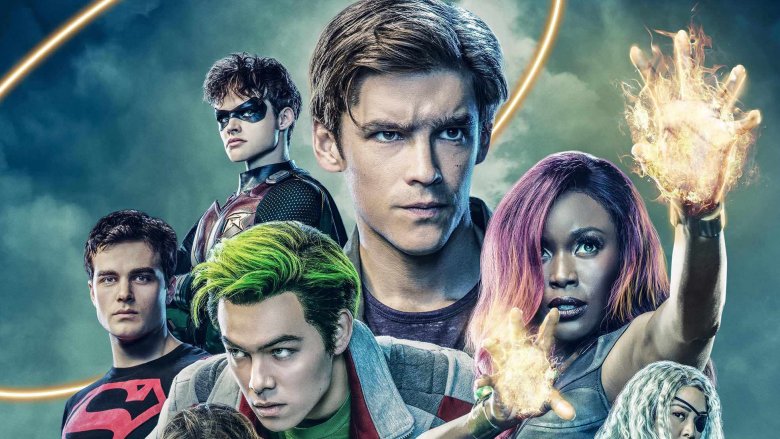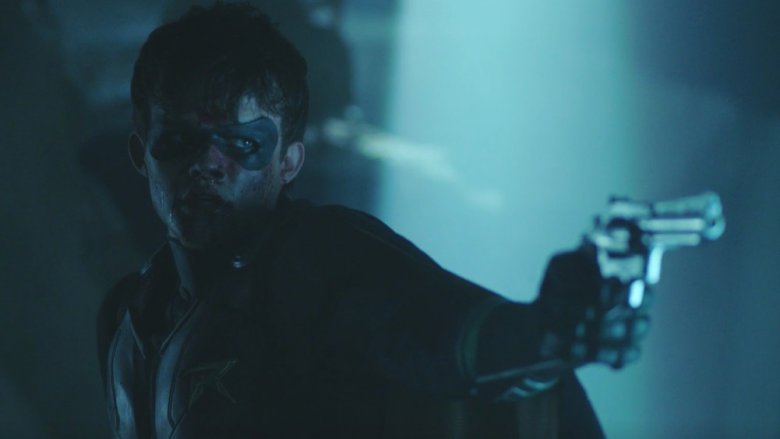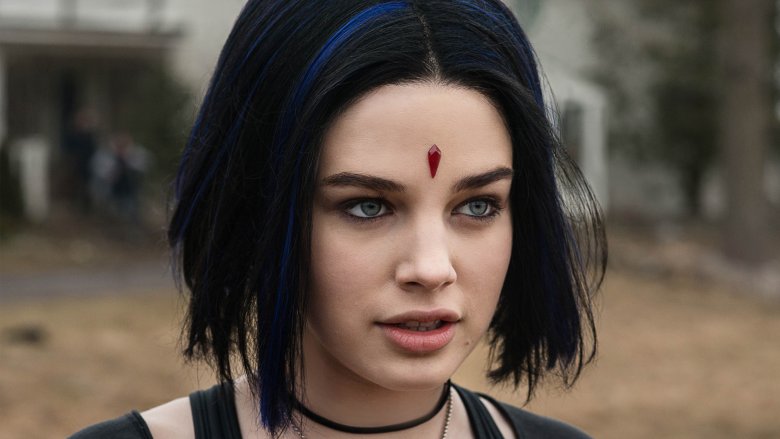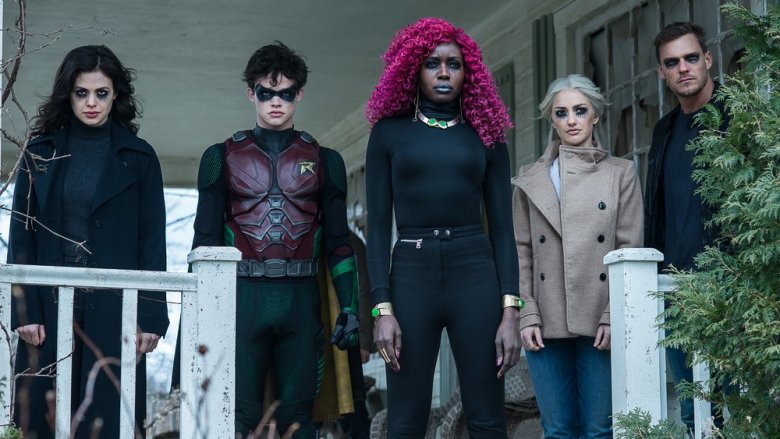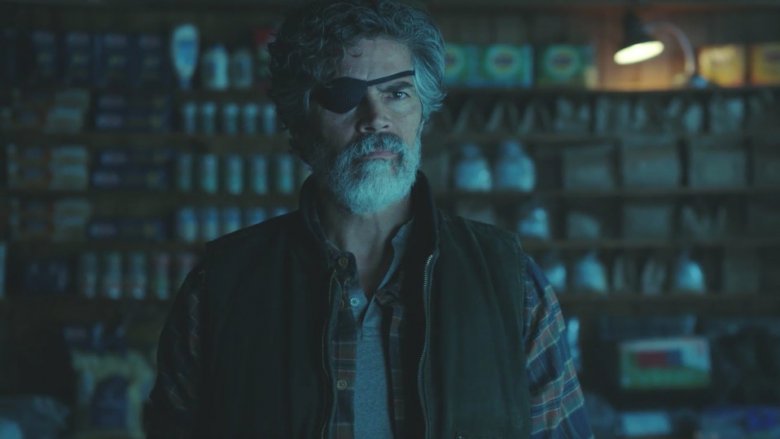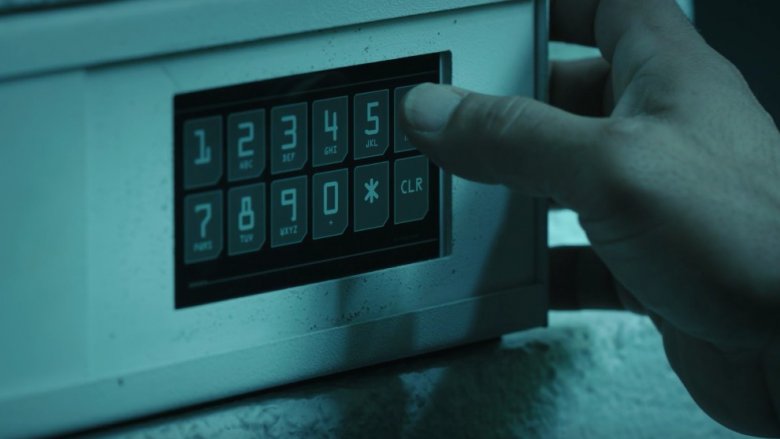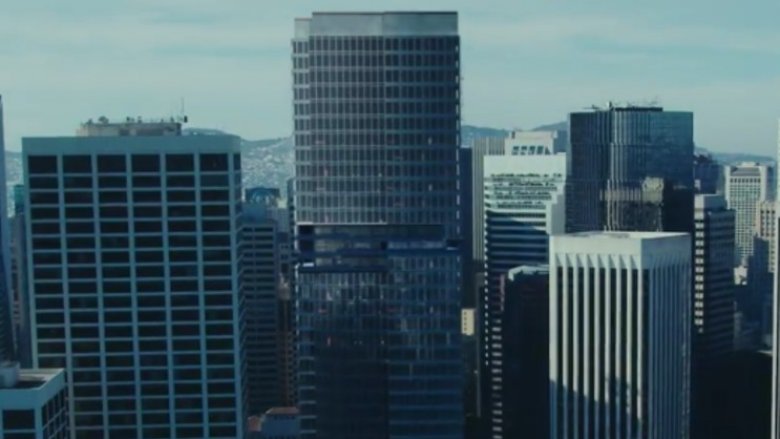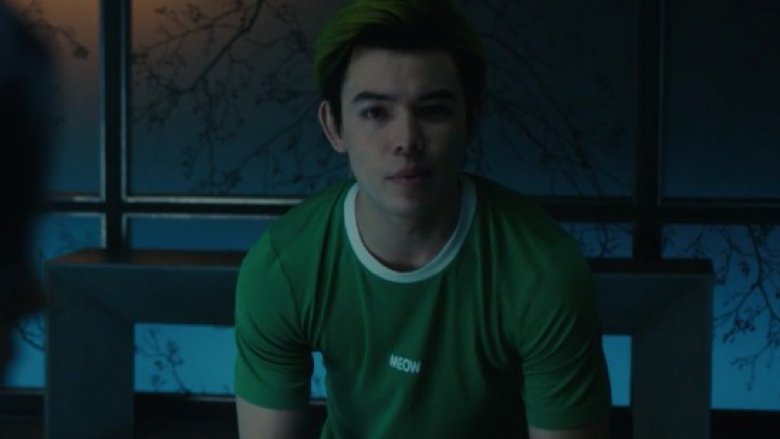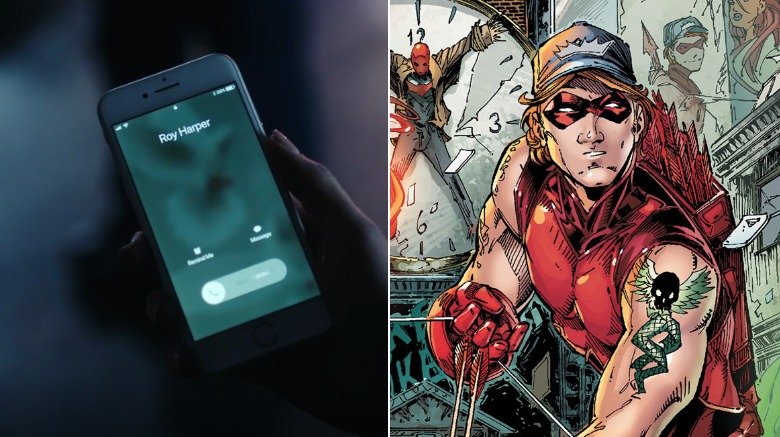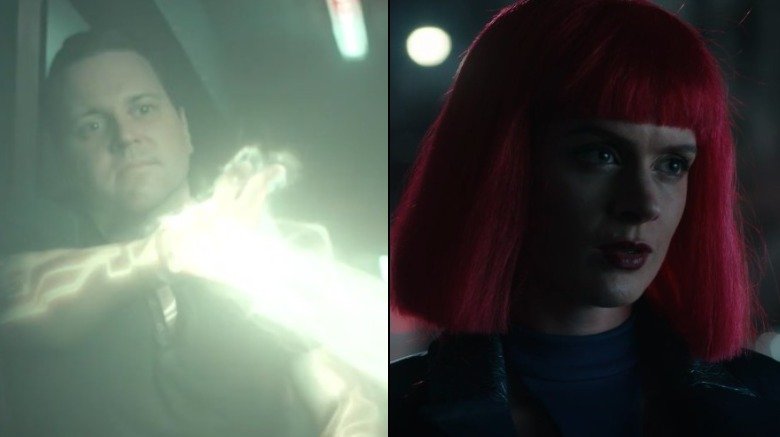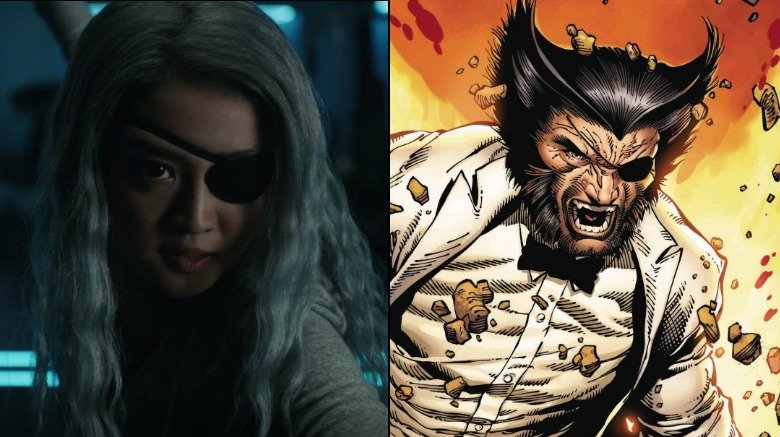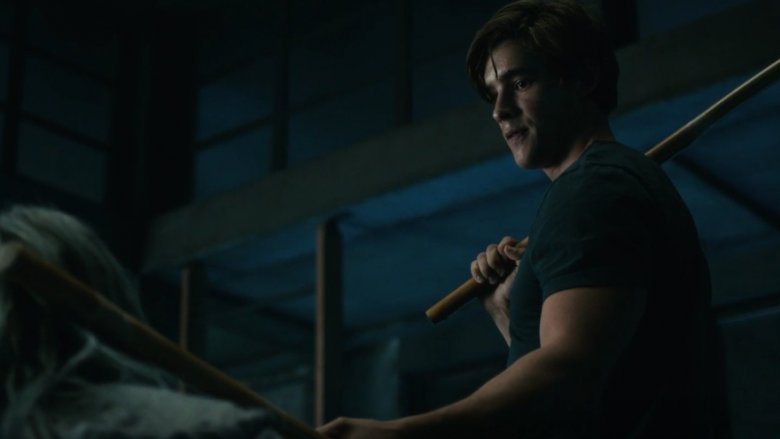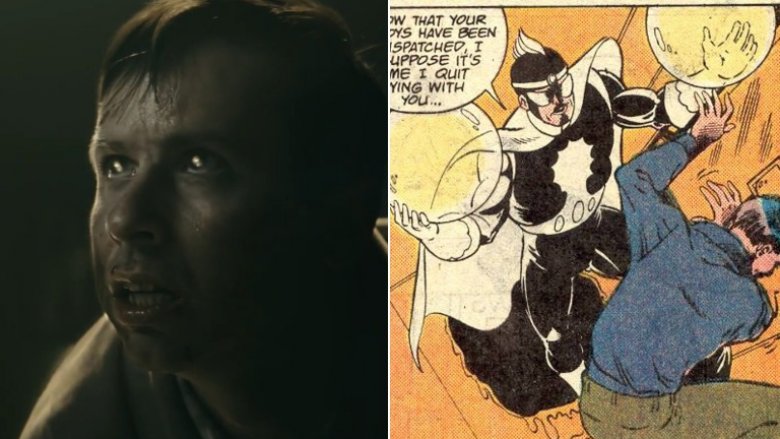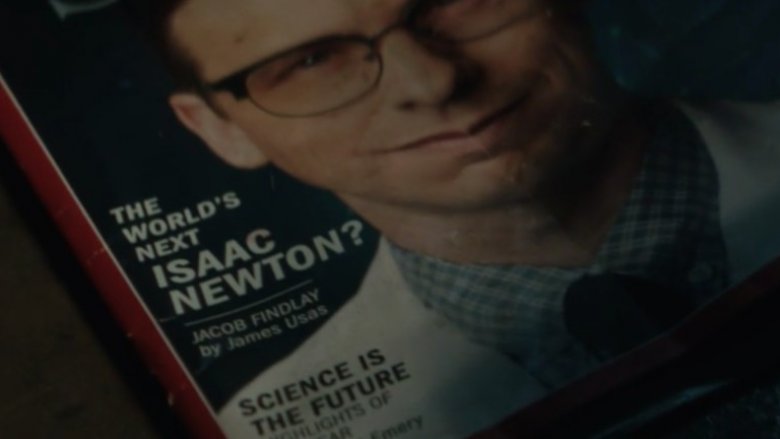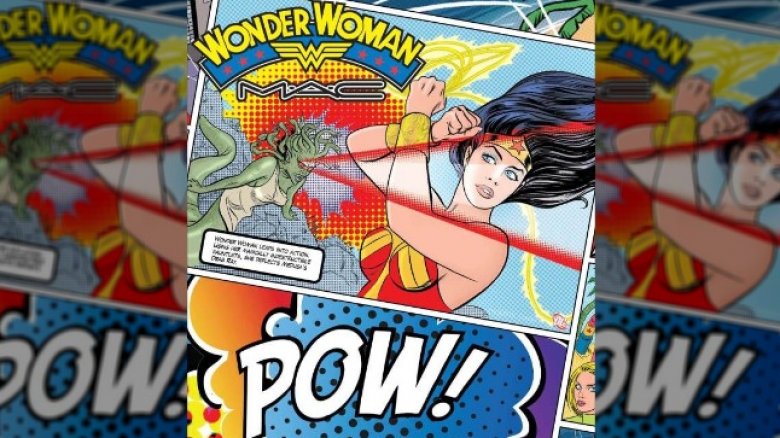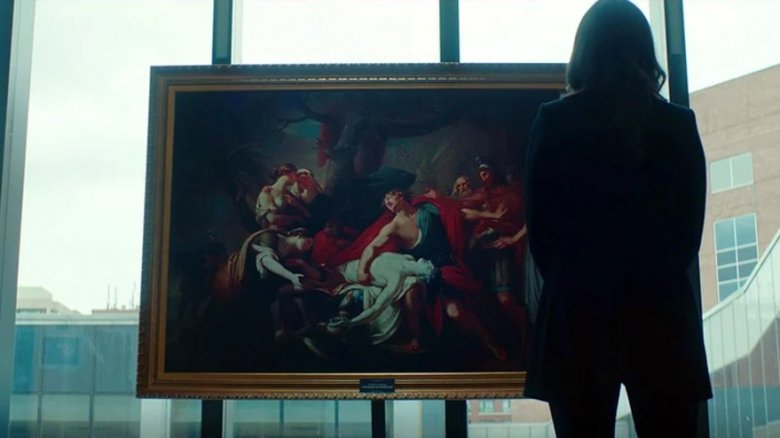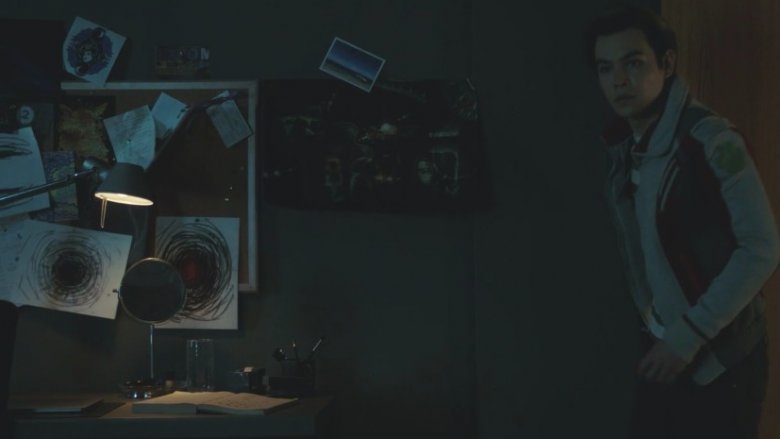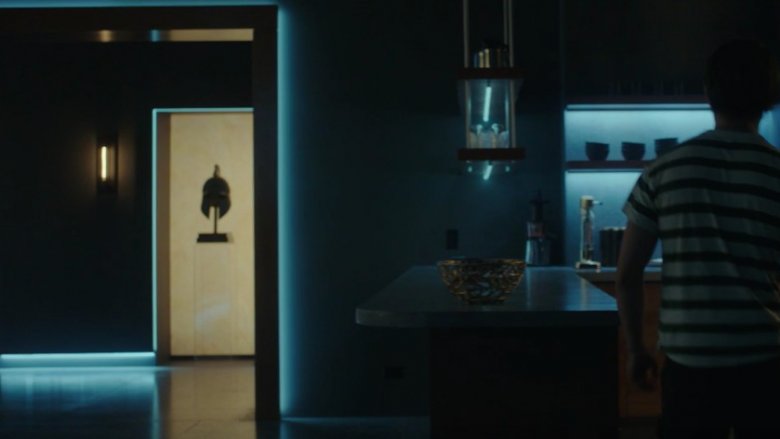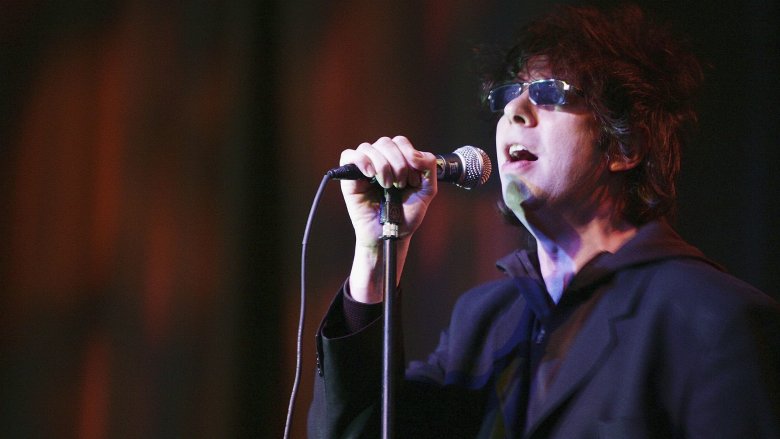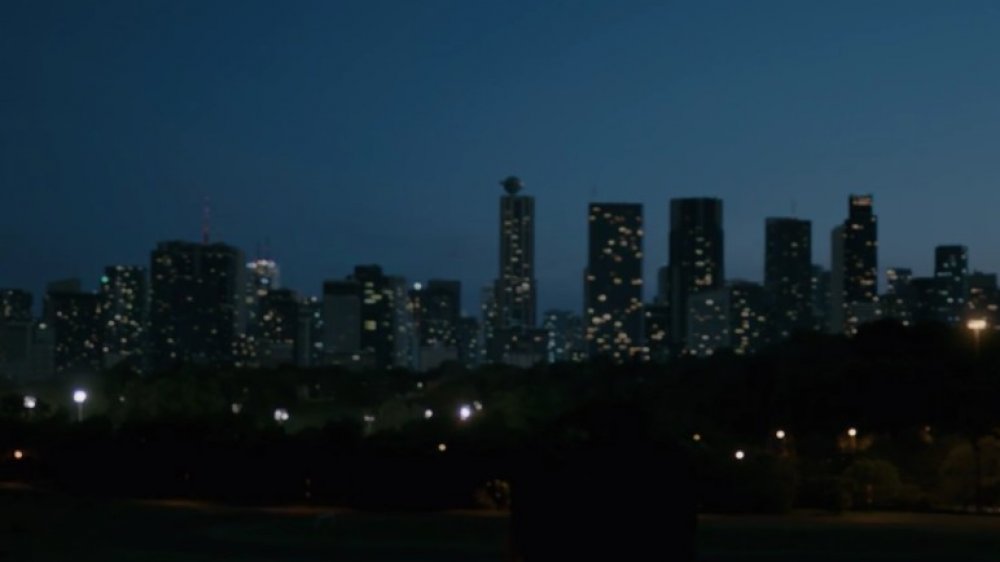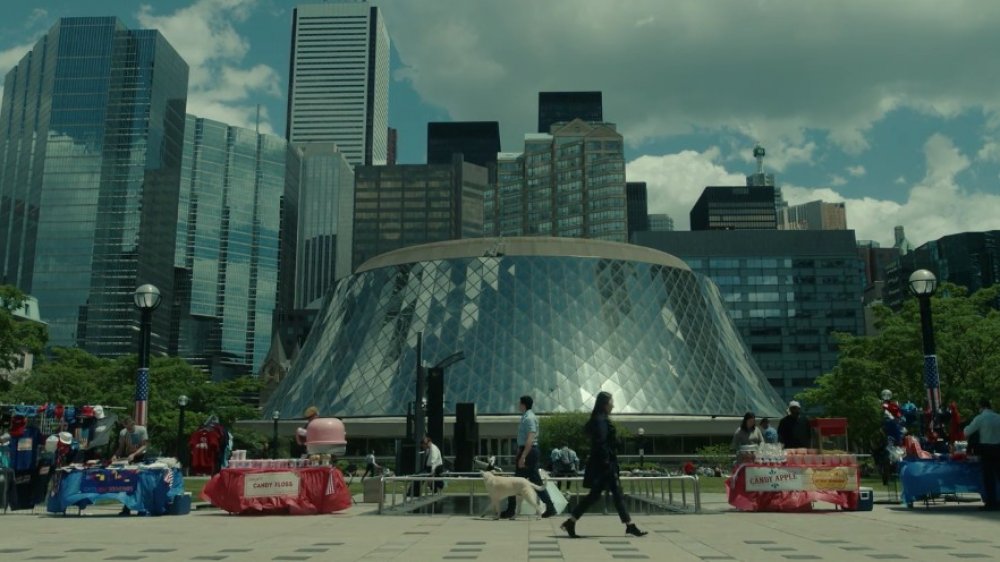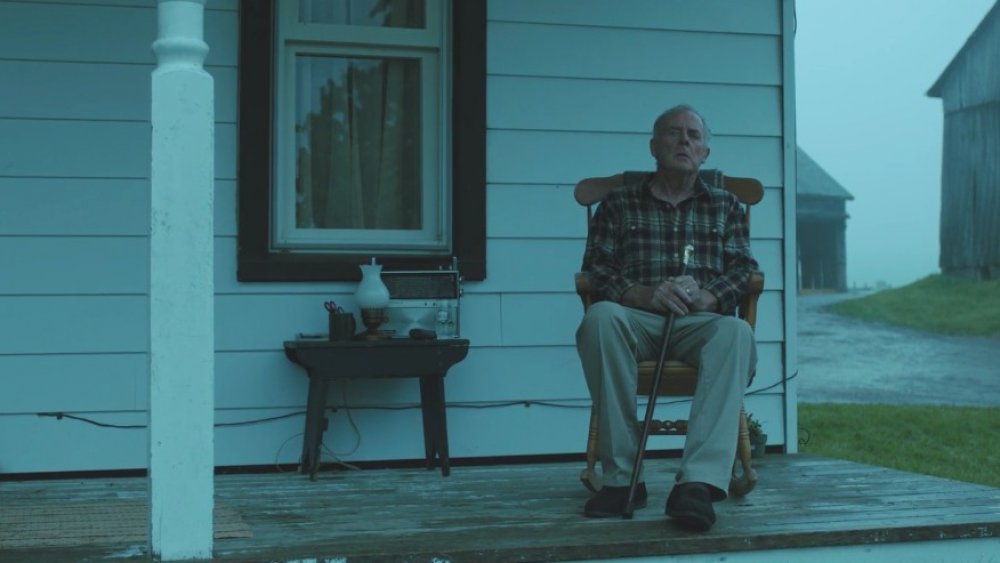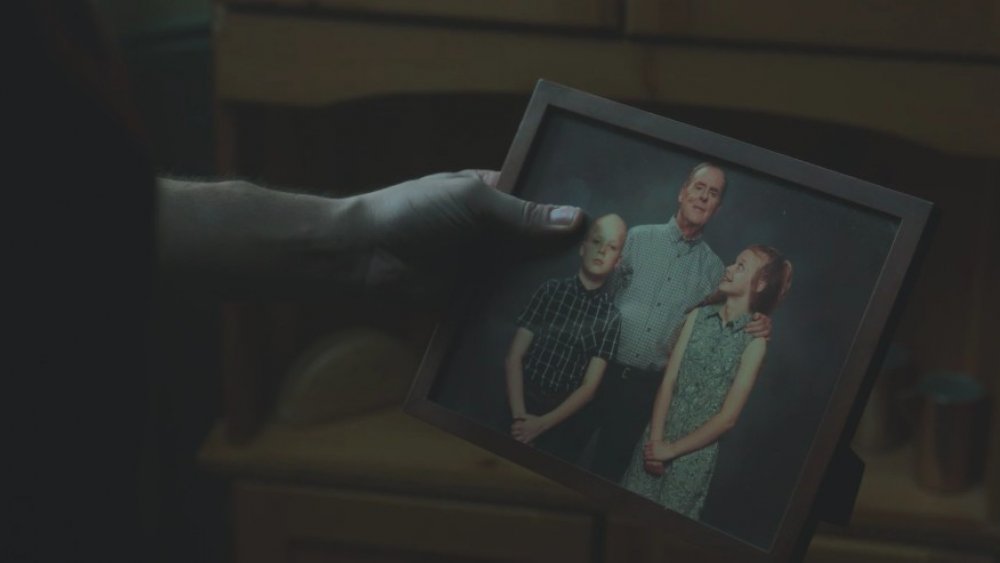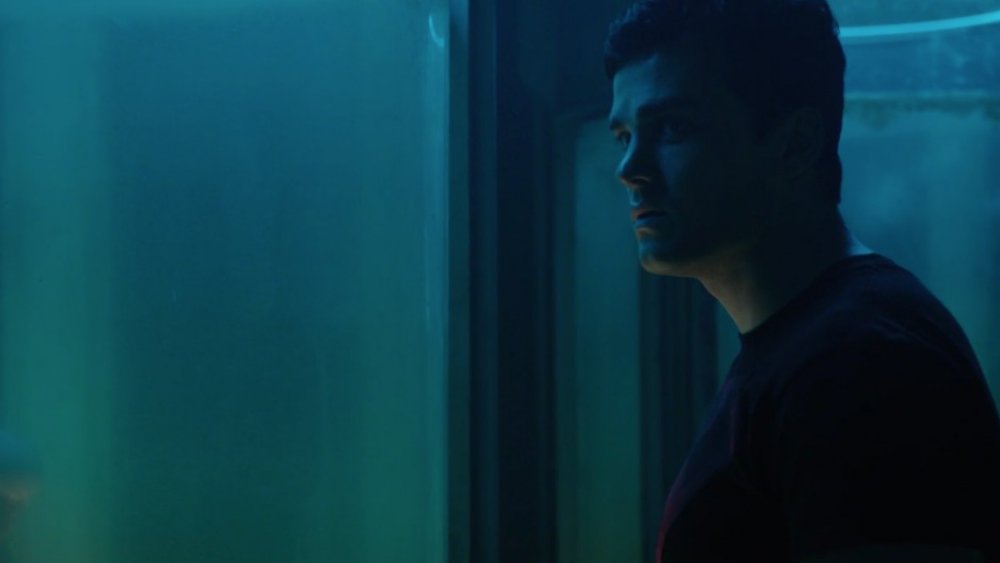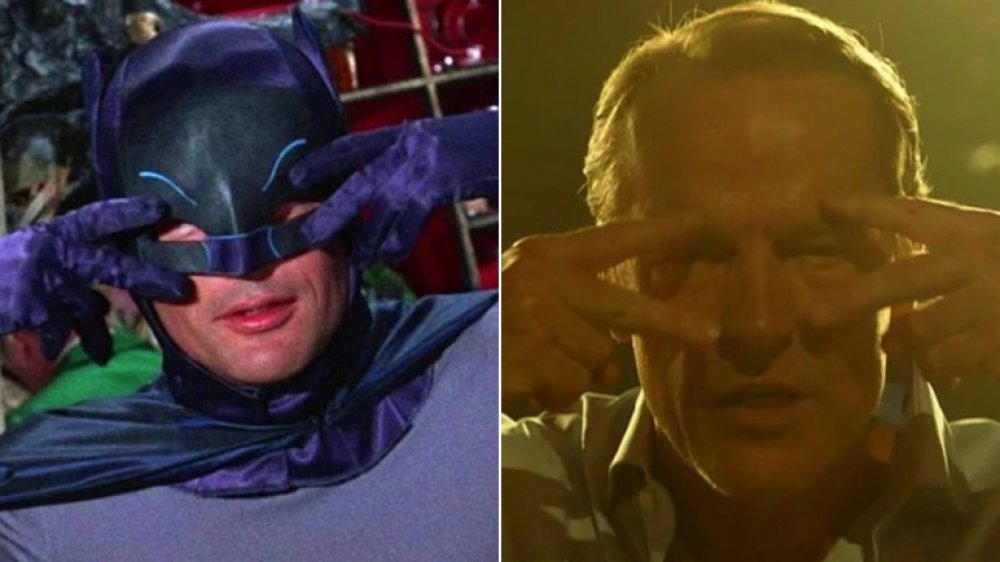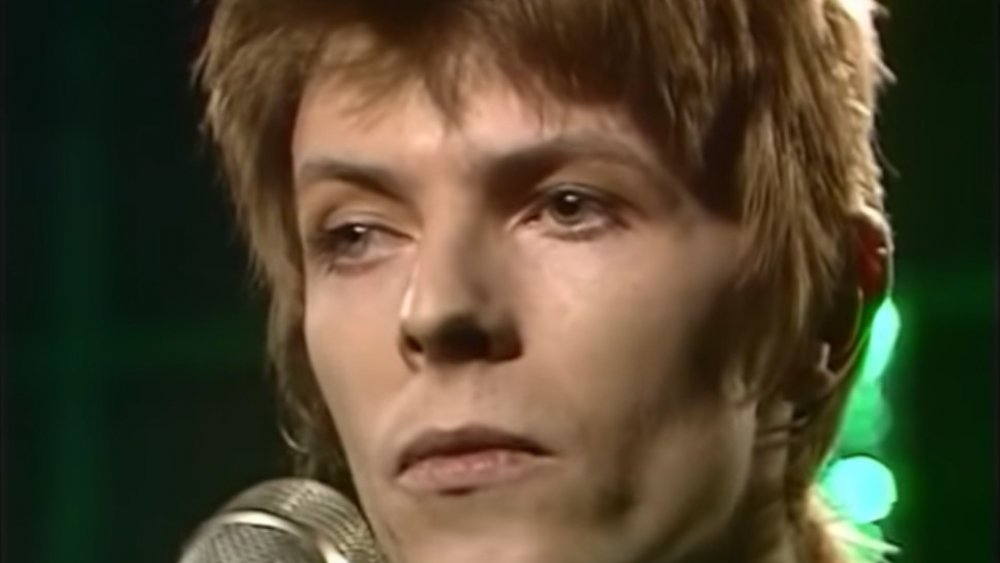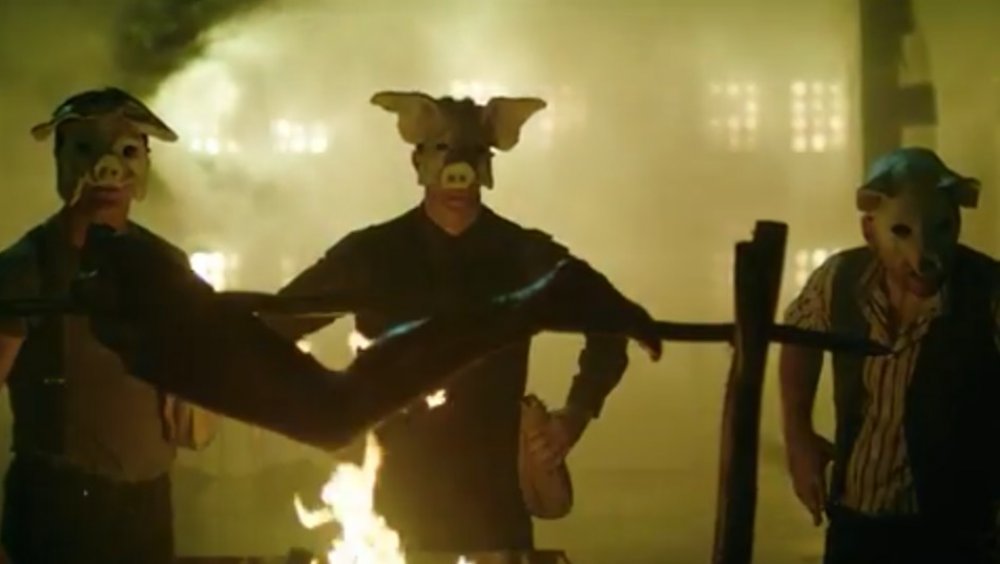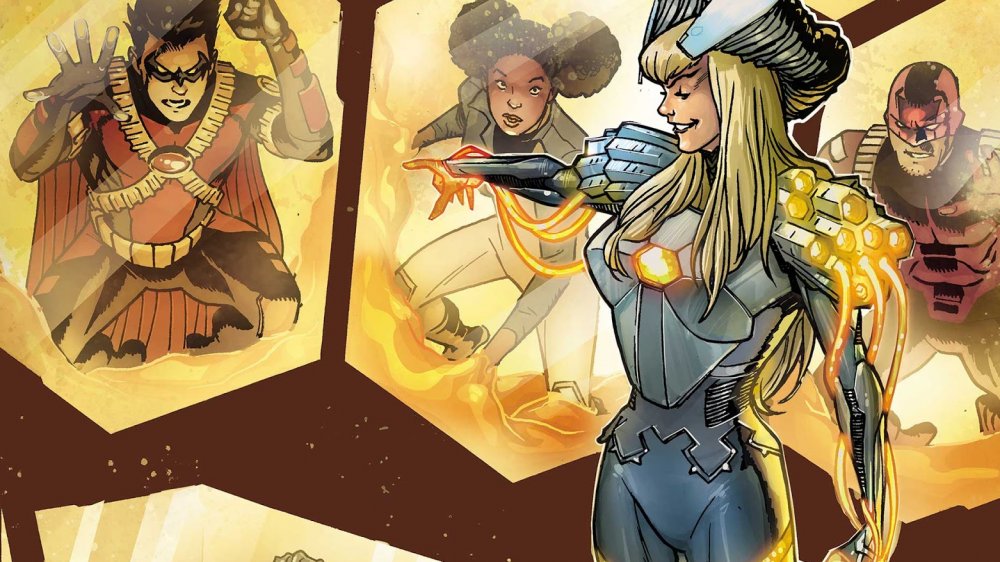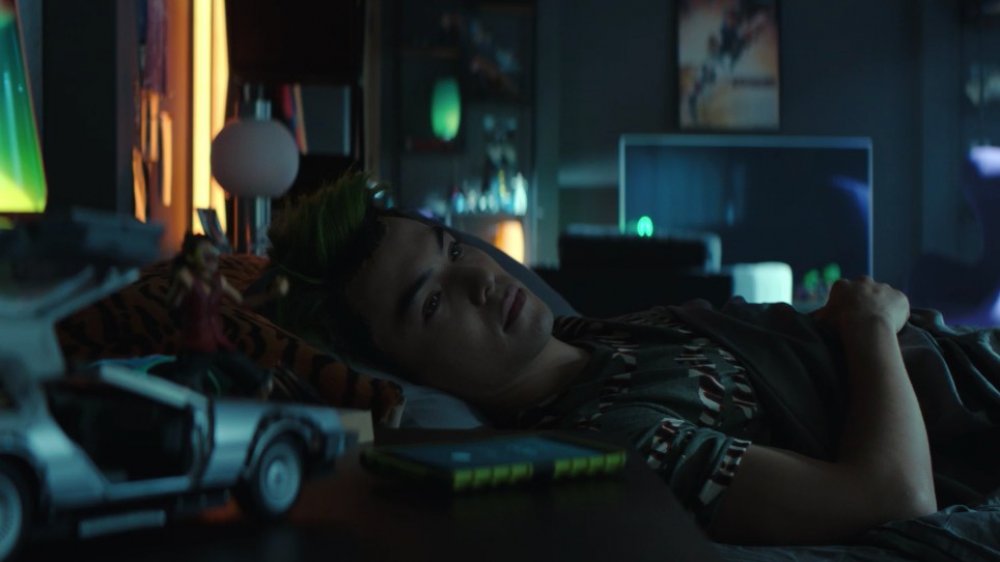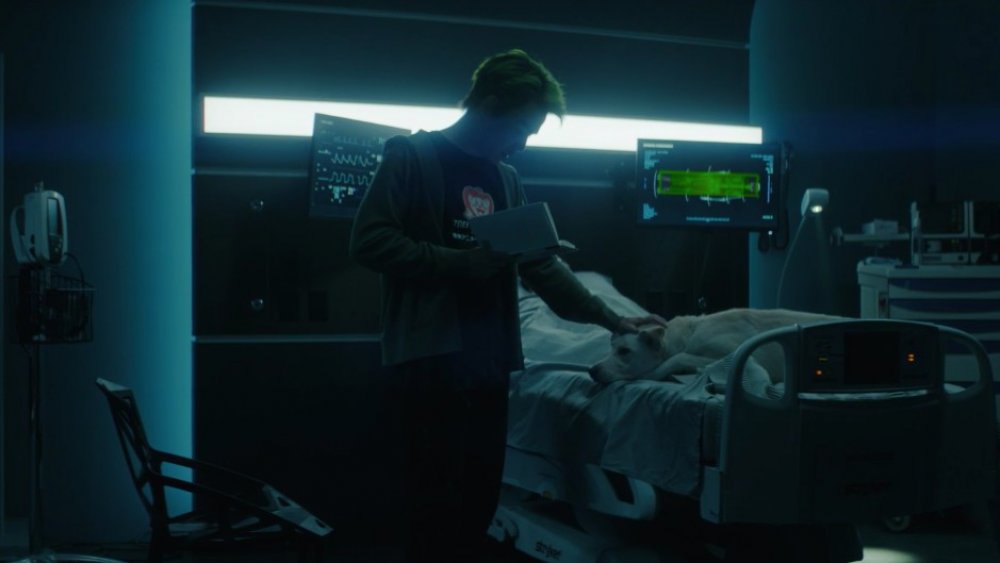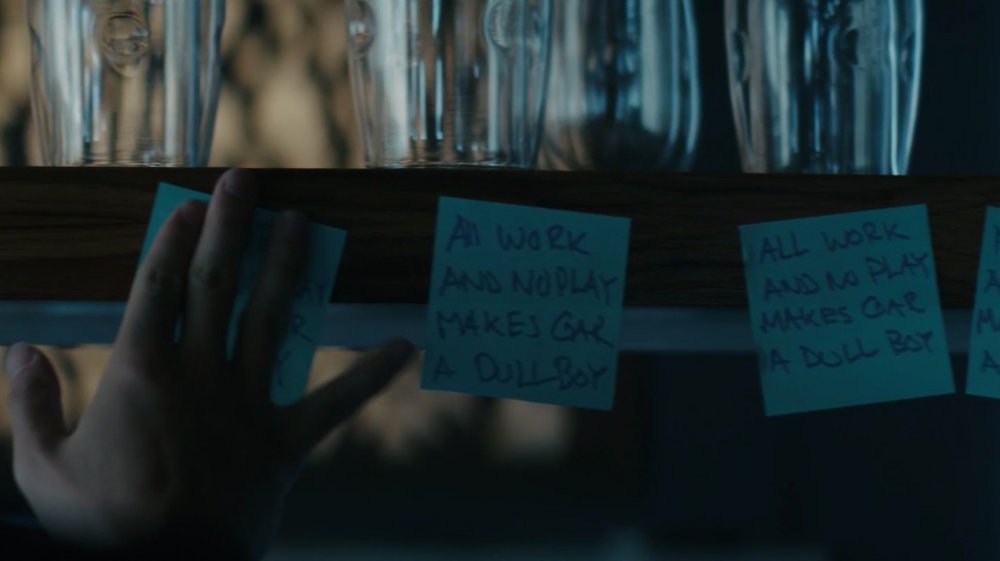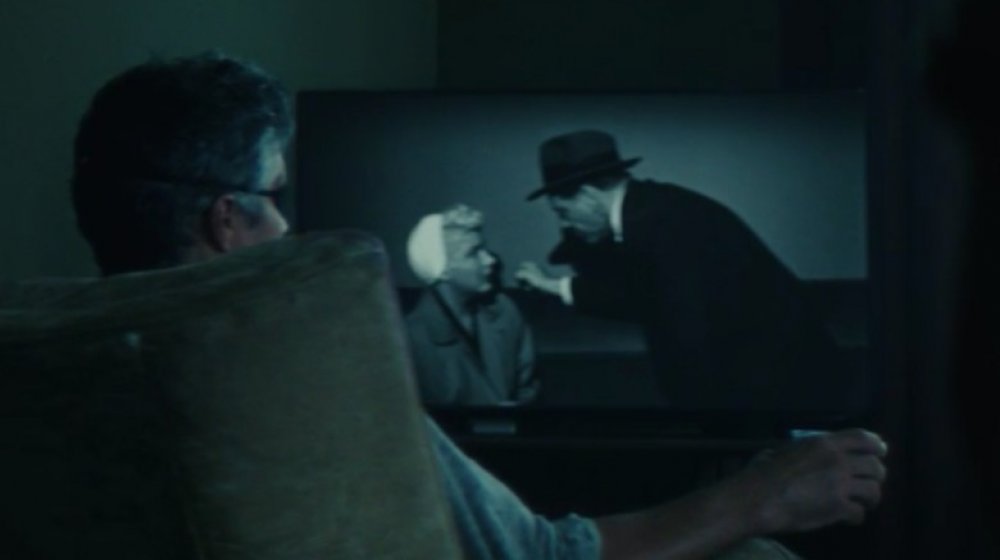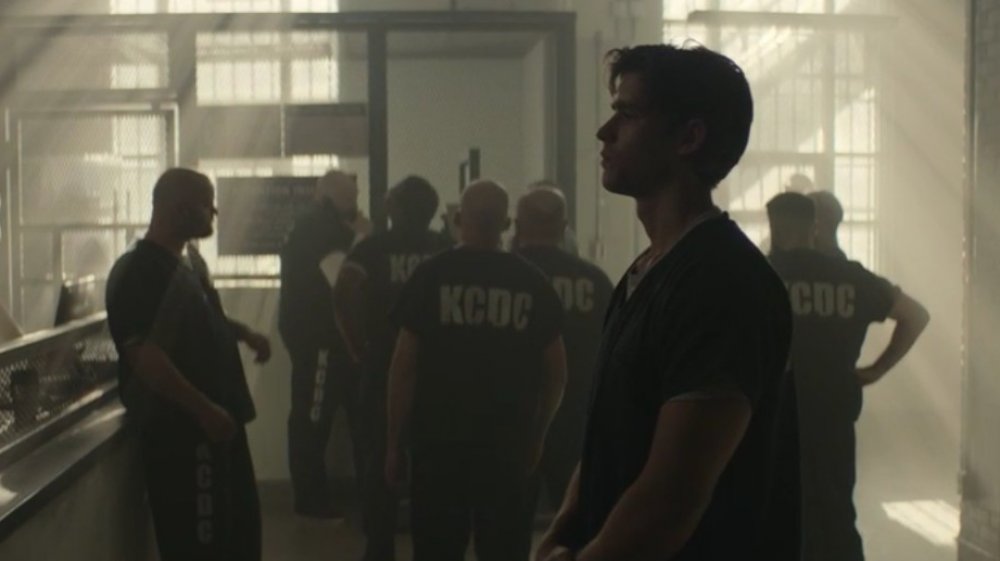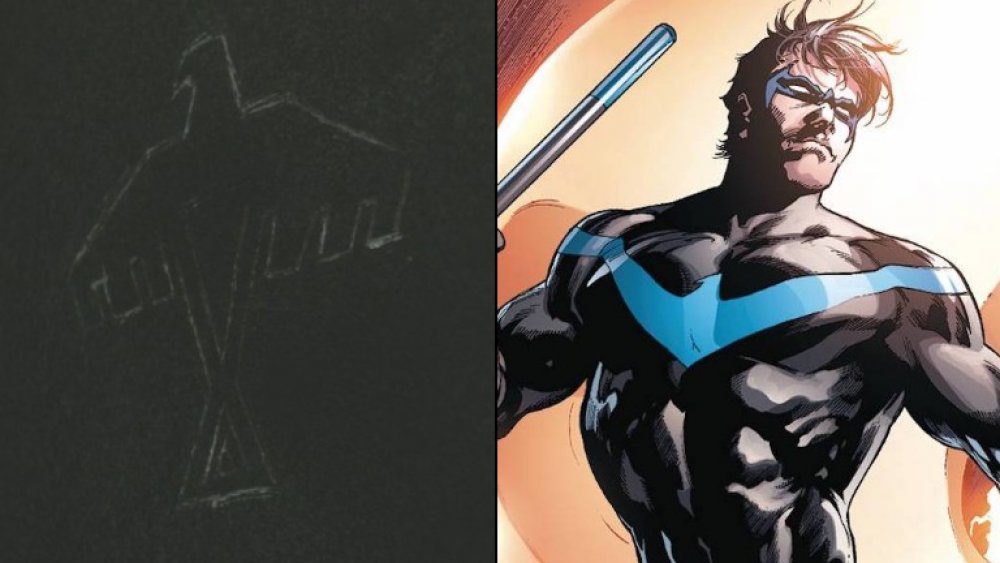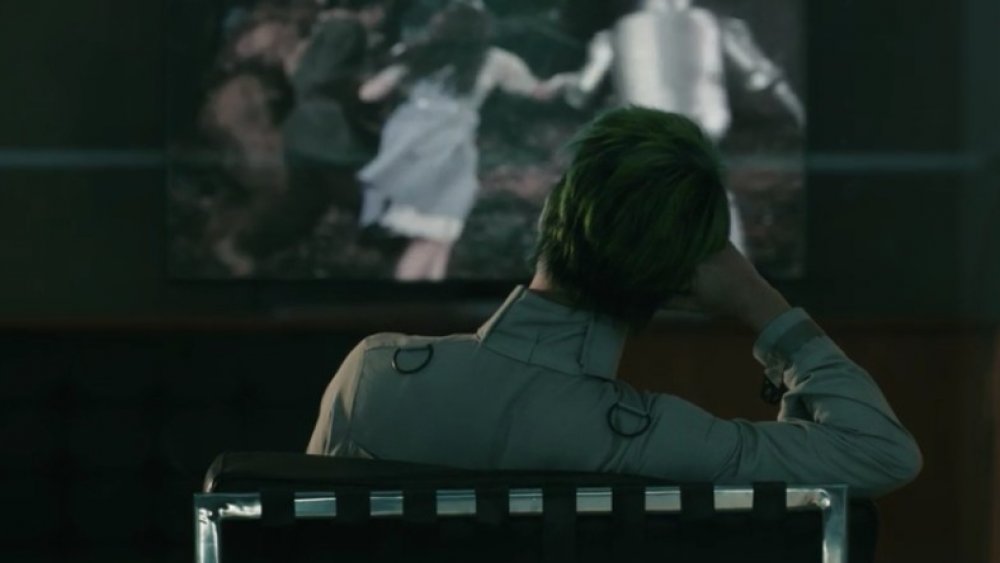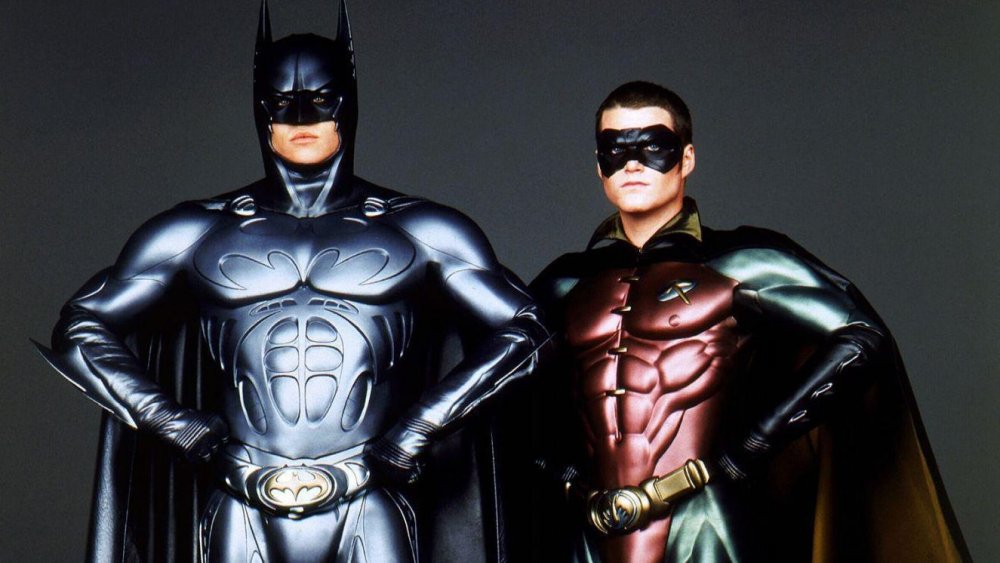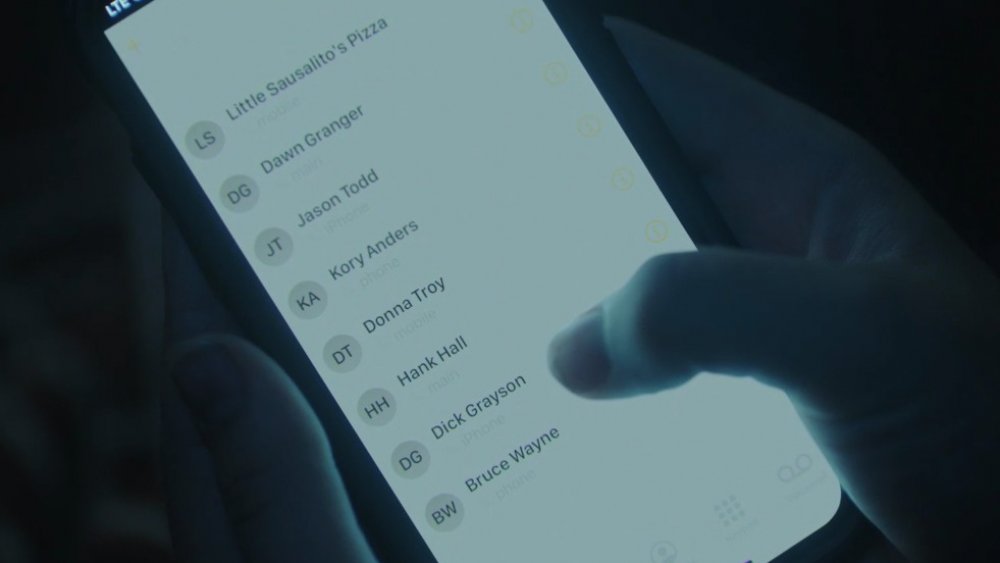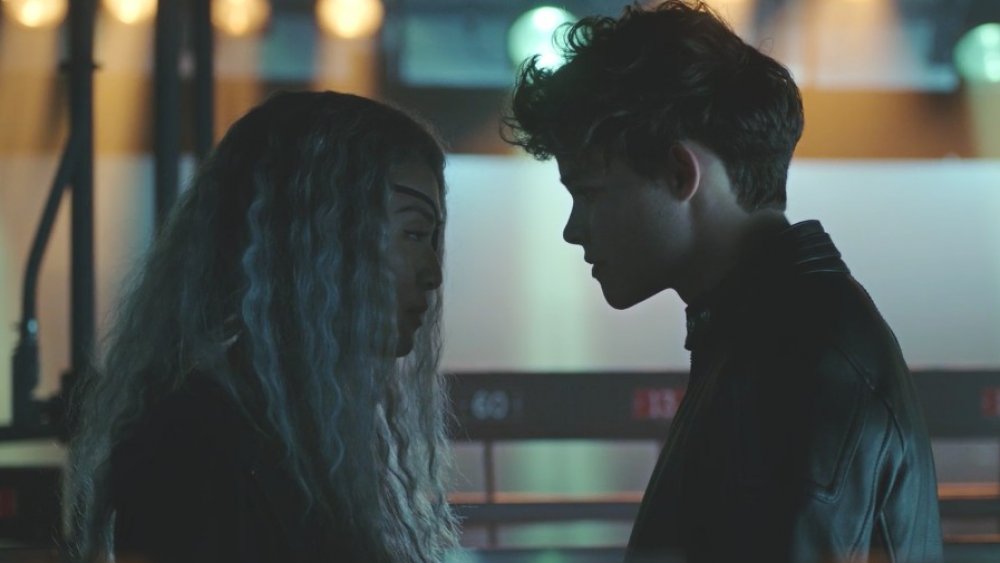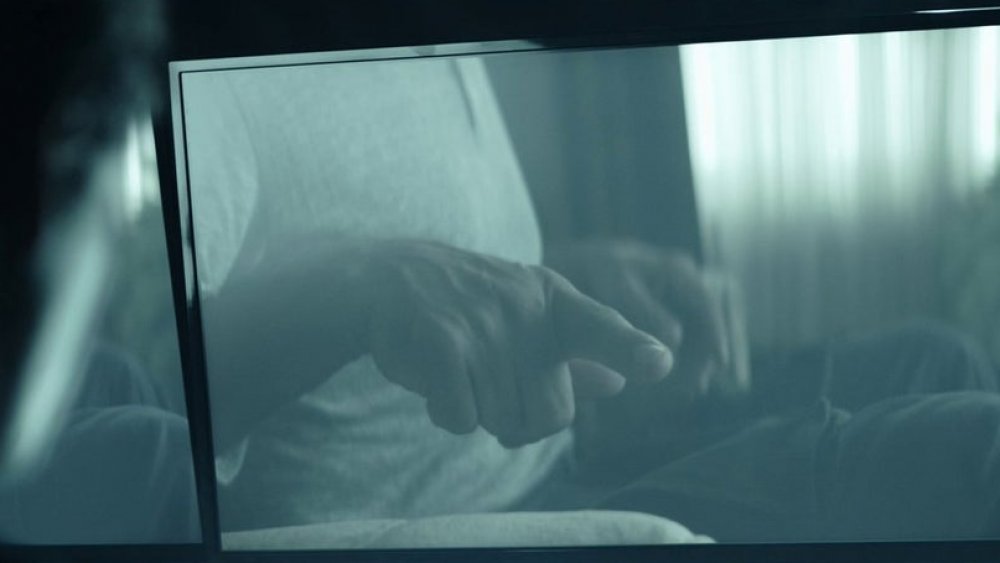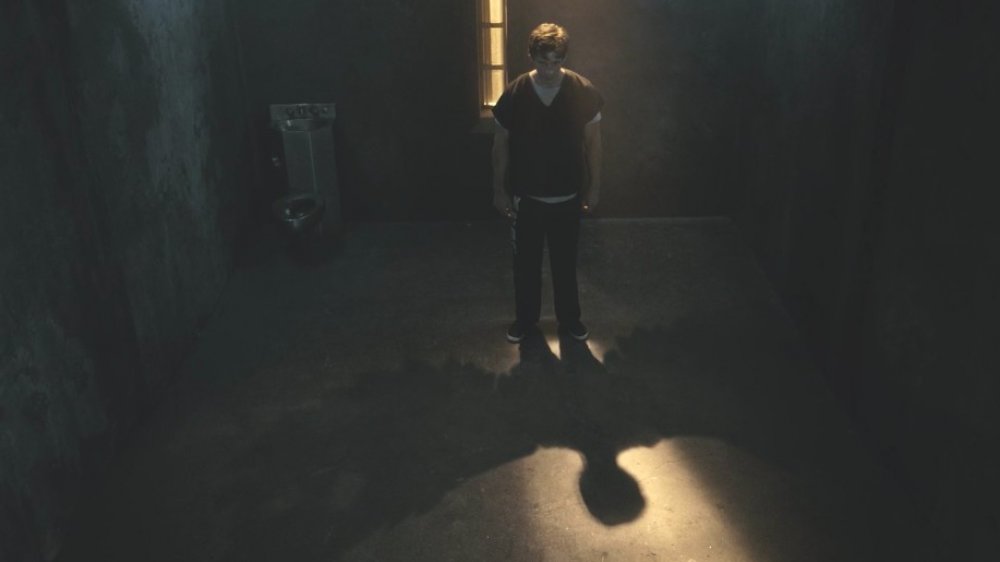Easter Eggs You Missed In Titans Season 2
Titans season 2 has arrived, and it looks like we're going to see a lot more of DC's rich universe this time around. Slade Wilson, a.k.a. Deathstroke (Esai Morales), shows up as early as the season 2 premiere. If you don't know Deathstroke, he's a ruthless mercenary who's walked the line between hero and villain in DC's various media for decades (and occasionally goes so far as to pick a side). Superboy (Joshua Orpin) and Krypto showed up in a post-credits scene in the season 1 finale, so we know to expect more of them. Aqualad (Drew Van Acker) is on his way, as is Deathstroke's daughter Rose, a.k.a. Ravager (Chelsea Zhang). Perhaps most intriguingly, we've finally gotten the chance to meet Titans' version of Bruce Wayne (Iain Glen).
Those characters aren't the only pictures of DC's Universe we're sure to get in season 2. Already the series has given hardcore comics fans a bunch of Easter eggs they'd be able to catch — and a few they might not. There are meaningful passcodes, direct swipes from comic book covers, and mentions of unseen beloved characters. We're breaking down all this and more in the Easter eggs you might have missed in Titans season 2.
Joe Chill's gun makes an appearance
The gun used to murder Bruce Wayne's parents makes something of an appearance in the Titans season 2 premiere. Trigon subjects the Titans to the same kinds of visions he used on Dick Grayson (Brenton Thwaites) in the season 1 finale. In the case of Jason Todd (Curran Walters), he inserts the new Robin into the end of Dick's vision, just after Dick has killed Batman. Dick tells Jason that the younger hero is an animal who "needs to be put down." Their fight ends with the infamous pistol inexplicably showing up on the floor near Jason. When Jason grabs the gun, Dick suggests Bruce would never keep the gun loaded. Jason answers, "No. But I do," and shoots the illusory Dick in the head.
This makes the gun's appearance more than just a nod to the comics. Does Jason actually keep Joe Chill's gun loaded while he's living with Bruce, or is that just part of the illusion? Considering we know that in the comics Jason Todd eventually goes down some dark roads — including becoming the lethal vigilante the Red Hood — it's possible that what he says isn't just part of Trigon's nightmare. If not, it would not only be a betrayal of Bruce Wayne's trust, but would point to a dark turn for the character in the show equal to what happens in the comics.
Raven's look gets a final touch
Throughout the different incarnations of Rachel — a.k.a. Raven (Teagan Croft) — in various media, she's usually seen with a diamond-shaped mark on her forehead. In some of those depictions, the mark is little more than decoration. It was completely absent in Titans' first season, but it finally makes an appearance in the season 2 premiere.
During the premiere, we hear Trigon and Rachel's mother Angela (Rachel Nichols) talk about how the prophecy foretelling Rachel's birth and the ascendance of Trigon will only come to pass once Rachel's heart has broken. When the rest of the possessed Titans beat Gar (Ryan Potter) nearly to death and Trigon refuses to heal him, the demon finally gets what he wants. He reaches into her chest and pulls out her still beating heart. The organ evaporates into dust, leaving behind only the red diamond that Trigon inserts into her forehead. Rachel initially seems just as under Trigon's sway as the rest of the possessed Titans, until Gar is able to break her free.
The Titans possessed pay tribute to a classic comic book cover
Just before Rachel defeats Trigon, the possessed Titans wait nearby, with the dark splotching around their eyes singaling their new loyalties. One shot in particular mirrors the cover of a comic that marked one of the more memorable battles between the Titans and Trigon.
The cover to 1985's New Teen Titans #4 — like the shot from the Titans season 2 premiere — shows the heroes standing in a row with their altered eyes letting us know they're under Trigon's control. The players aren't all the same — the cover to the comic shows Beast Boy, Kid Flash, and Cyborg. Also, their eyes are colored red rather than the skin around their eyes taking on that inky black look. Regardless, the meaning behind the respective eye effects are clear, as is the inspiration the show takes from the comic.
In New Teen Titans #4, the heroes are forced to individually wrestle with Trigon's power just as they are in the season 2 premiere, but in a much more literal sense. Rather than being exposed to nightmare visions that usually lead the heroes to making horrible — and often lethal — choices, the heroes of New Teen Titans #4 fight gray-skinned, red-eye shadow versions of themselves in the real world.
Slade Wilson's tea preference is telling
In the scene introducing Slade Wilson, one tiny detail you may have missed speaks to the mercenary's complicated history. Shortly after we meet Slade in his cottage, we cut to a small country store where Slade gets supplies from a shopkeeper who seems to do a lot of business with him. The shopkeeper mentions a "foreign tea" Slade had requested, saying he had to go online to find it. He goes to the back of the shop briefly. While he's gone, Slade sees a news clip informing him the Titans have reformed. The store owner returns with what he calls "Chinese Chrysanthemum Tea" and he jokes, "Seriously, why do you hate America?"
The small moment confirms that at least a few things about the Deathstroke of Titans will be similar to his comic book counterpart. The Slade Wilson of the comics has spent a lot of time outside the States, usually killing people for money. The tea lets us know he's probably spent a significant amount of time in Asia, just like the Slade of the comics. And the store owner's joke suggests this is just one of many international items he's requested from the shopkeeper.
Slade's passcode has more meaning than you know
One of the more interesting moments in the brief scenes involving Deathstroke is when he enters a passcode to open his private arsenal. The conversation between Slade and Wintergreen (Demore Barnes) suggests it's been a while since Slade has been home, and the scene in the country store would suggest it's the re-emergence of the Titans that has brought him back. When Slade and Wintergreen approach the arsenal, for a moment it seems Slade may have forgotten the passcode. Wintergreen offers to enter it himself but Slade insists, "It's my house." The code he enters — "5639" — works, and once you see the code you may wonder if it was his memory that was bothering him, or the code himself.
The passcode isn't just a random grouping of numbers. If you look at the letters corresponding to the numbers on the keypad, it seems clear they're based on a name: "Joey." Joey is a meaningful name in the Deathstroke mythos, as it's the first name of Jericho (Chella Man), Slade Wilson's youngest son.
Jericho has a turbulent history in the comics. In the source material the young hero actually sides with the Titans against his father, and at one point Slade is forced to kill Jericho when his son is possessed by Trigon. Later in the season we find out it's Jericho's presumed death five years earlier that set him on a collision course with the new iteration of the Titans.
The Titans are home
The beginning of season 2 not only sees the Titans get a home, but gives us the appearance of one of DC Comics' heroic monuments: Titans Tower. In most media before now, Titans Tower has usually been represented as it was originally in the comics, as a giant T-shaped building. It's also usually separated from the mainland on its own island.
We don't get quite the same tower in Titans, but the show does pay tribute to the comic book version. Though the Tower clearly is made to look more like a regular office building than the T-shaped headquarters of the comics, when the camera pulls back from the Tower at the end of the season 2 premiere, the Titans' living space is highlighted while a shadow falls on the bottom half of the building, making it look like an accidental T shape is being formed.
Gar's fashion sense truly reflects his inner self
Gar, a.k.a. Beast Boy, doesn't see a lot of action in the second episode of season 2 besides his sparring practice with Jason Todd. Nevertheless, Titans' wardrobe department found the perfect shirt for the shape-changing teen.
For most of the episode, starting with his visit to Rachel, Gar is wearing the perfect Beast Boy shirt. Look closely and pause in the right spot, and you'll see that Gar's bright green shirt has the word "MEOW" across the front, echoing his ability to change into the forms of animals — most often, so far, a tiger.
In fact, for a while, it seemed like a tiger is the only animal Gar could change into. After the possessed Titans beat Gar nearly to death in the season 2 premiere, we watch him sneak across the floor as a green snake. This wouldn't be a surprise in the comics, since Gar can change into just about any animal (even ones that don't otherwise exist on Earth). But every time we saw him change back in the first season of Titans, it was exclusively into the form of a tiger, which might have left fans wondering if maybe that's all the DC Universe series version is capable of. Thankfully, it appears Gar has more range than that.
Donna's keeping Arsenal in the loop
Probably the most blatant Easter egg we've seen in Titans season 2 by the second episode is a phone call Donna Troy (Conor Leslie) gets after she and Kori (Anna Diop) hand off the villain Shimmer (Hanneke Talbot) to the police. As her phone rings, she looks at the screen and we see the name "Roy Harper" pop up.
Roy Harper has had a number of different superhero codenames over the years, the most recent being Arsenal. He was once known as Speedy, Green Arrow's sidekick. Colton Haynes occasionally plays the character on CW's Arrow, and in the comics he was one of the many superheroes to die in the 2018-2019 mini-series Heroes in Crisis.
Could this be a precursor to Arsenal joining the Titans? There's no news about such an addition, but anything's possible. It could be that Donna and Roy are dating and that's the reason for the phone call. Or perhaps Roy was a member of the previous incarnation of the Titans, and — like everyone else in the season 2's second episode — he has news about the re-emergence of Doctor Light (Michael Mosley).
The Fearsome Five may be on their way
The second episode of Titans' second season introduces two supervillains, both of whom have a long history with the Titans of the comics: Doctor Light and Shimmer.
The legacy of Doctor Light has long been tainted by one of the most disturbing moments in DC Comics history. Ever since the 2004 mini-series Identity Crisis, in which he is revealed to have sexually assaulted Sue Dibny (wife of Ralph Dibny, the Elongated Man), it's been tough for fans not to cringe upon hearing his name. Long before that, he was a crook most closely associated with the Teen Titans, and the fact that he's introduced in the same episode as Shimmer is likely not a coincidence.
Doctor Light and Shimmer are both members of the Fearsome Five, and incarnations of the team also tend to include Shimmer's brother, Baran Flinders, a.k.a. Mammoth. Other members include the psychic Psimon and the tech-savvy Gizmo (no, not the little dude from Gremlins). Since Deathstroke eventually murders Doctor Light, it seems likely any emergence of the Fearsome Five won't include him. Of course, with super-heroes and their more villainous counterparts, you never can tell.
Rose comes up with a codename, but it's taken
The third episode of Titans' second season, "Ghosts," has a little bit of fun with DC Comics' longtime competition.
Hank, Dawn, and Donna finally show up to Titans Tower to help hunt down Doctor Light, but they aren't too happy when Dick tells them Deathstroke's daughter is chilling out in a bedroom nearby. Shortly after the exchange, Dick visits Rose in her bedroom and brings her a black eyepatch to replace the white bandage she's been wearing since she was introduced in the previous episode.
Later that night, Rose has an uncharacteristically friendly conversation with Rachel in the Titans' kitchen. Rachel tells Rose her name is pretty. "Maybe too pretty now," Rose says. Then she jokes, "Patch has a nice ring to it." This just so happens to be a nickname Wolverine has carried in the pages of X-Men comics.
Rose helps Dick Grayson with his future upgrade
Frustrated with Doctor Light's escape and his confrontations with the other Titans, Dick takes his anger out in the sparring room. Rose finds him there and taunts him into sparring with her — Rose with her sword and Dick with a staff. Dick wins the short duel, but not before Rose slices his staff in two. Rather than toss aside the staff or admit defeat, Dick adapts and uses the two halves of the staff as batons.
In the comics, Dick eventually retires his Robin costume to become Nightwing, and in Titans second season finale we finally see the evolution happen on screen. Accepting his need to evolve beyond being either Robin or Dick Grayson, Dick finally shows up to take down Deathstroke in his new Nightwing uniform.
Doctor Light's victim is actually the first Doctor Light of the comics
Fairly early in the episode "Aqualad," we see Arthur Light, a.k.a. Doctor Light, torturing Dr. Jacob Finlay (Dan Beirne). Their conversation indicates the two have a history. We don't hear a lot of specifics, but the gist of it seems to be that Finlay has won respect and fame on Doctor Light's shoulders. They make reference to failed work Light did that Finlay was able to improve upon, and subsequently take all the credit for.
The name Jacob Finlay comes directly from the comics and ironically, in the comics things are a little bit backward. When we first meet Finlay in 1989's Secret Origins #37, he appears as an apparition to Arthur Light in a Doctor Light costume. A flashback unfolds in which we learn Finlay was the original Doctor Light before Arthur Light took up the name. And unlike Arthur Light, Finlay wanted to use his abilities for good. After Finlay dies, Arthur takes his suit and his powers, but continues to be haunted by Finlay's ghost.
The set designer for Titans is a writer too, according to a magazine cover
When Doctor Light tortures Jacob Finlay, a blink-and-you'll-miss-it Easter egg pays tribute not to a comic book or another DC-inspired TV show or movie, but to one of the Titans' crew. When Doctor Light slams a copy of a magazine in front of Finlay — an obvious clone of Time that is instead titled Span — Finlay's face is on the cover. The tease for the cover story asks "THE WORLD'S NEXT ISAAC NEWTON?" And below: "JACOB FINDLAY [sic] by James Usas."
Well, James Usas isn't a D-list supervillain or a well-kept comic book secret. Instead James Anthony Usas is the set designer for every episode of Titans' second season. In the last few years, Usas has made a name for himself as a set designer on series like The Expanse and Star Trek: Discovery.
On the Span cover, Finlay's name comes with an extra "D" that isn't in the comics or the credits. It leaves us wondering if this tribute to Usas is at least partly meant to poke fun at the set designer. It's pure speculation, but maybe on the Titans set Usas is known for having the spelling skills of a certain former Vice President?
Aqualad can joke all he wants — Themyscira Mascara is a real thing
Much of "Aqualad" revolves around the doomed Garth trying to woo Donna Troy. In one of his conversations with Donna, Garth teases her with a joke about her tongue twister of a homeland. When Donna mentions she will be leaving soon for Themyscira — the same island from which Wonder Woman hails — Garth says "You mean 'The Mascara?'" Well, whether or not Aqualad knows it, Themyscira Mascara is totally a thing.
In 2011, MAC Cosmetics released a Wonder Woman-themed line of makeup products, complete with Wonder Woman artwork by renowned artist Michael Allred. The line included such products as Obey Me nail polish, Athena's Kiss lip gloss and, yes, Themyscira Mascara.
It's probably a good thing Garth makes his joke to Donna Troy rather than another older, less forgiving Amazon who might not take kindly to having her homeland compared to cosmetics. Otherwise, Deathstroke might never have gotten a chance to shoot Garth, because the Atlantean heart-throb would already be in the hospital with a mouthful of broken teeth.
A painting hints towards Donna Troy's plans for Deathstroke
After Aqualad is murdered by Deathstroke, we find Donna Troy standing solemnly in front of a painting at Jillian's (Ann Magnuson) museum. In particular, she's regarding a classical painting that appears to include a group of people mourning over a recent death. She's still looking at this painting when she tells Jillian that she won't be going to Themyscira, and Jillian subsequently warns her that vengeance is a dangerous road.
The painting isn't just decoration, nor is it significant just because it depicts death. Painted by Gavin Hamilton some time between 1760 and 1763, the painting is Achilles Lamenting the Death of Patroclus. Achilles is a Greek demi-god pivotal to the story of the Trojan War as it's depicted in Homer's The Iliad. After the Trojan hero Hector kills Achilles' friend Partroclus, Achilles gets his vengeance by defeating Hector in battle and slaying him. The fact that Donna Troy is regarding this painting with such purpose right after Garth's death is no mistake.
If you've seen 2004's Troy you may recall its depiction of the battle between Achilles (Brad Pitt) and Hector (Eric Bana). Not only does Achilles kill Hector, but he refuses to return his body to the city and instead lashes it to the back of his chariot so he can drag it across the ground. So... you know. That should give you an idea of where Donna Troy's mind is at in terms of Deathstroke.
Revealing artwork in Rachel's bedroom
Toward the beginning of the fifth episode of Titans' second season, "Deathstroke," Gar hears something strange going on in Rachel's bedroom. He finds a weird, oily black substance flowing out of and around Raven as she sleeps. Eventually it cuts Gar, and later in the episode Rachel shows fresh cuts to Kori on her own back from the nightly events. We don't know what the exact nature of this energy is yet, though it seems obvious it has something to do with how Trigon altered Rachel's powers in the season premiere.
As Gar enters the room, there's a shot of something that, under the circumstances, should be concerning everyone involved, though we have yet to hear anyone mentioning it. Posted on a cork board above Rachel's desk are a number of images that wouldn't necessarily be disturbing... if they weren't being drawn by the daughter of a demon. Rachel's creative side seems to be very interested in black, abyssal holes. One appears like a spiral and another seems more like an impact crate, but they're all dark, foreboding, and likely connected with the darkness continuing to emerge from Rachel herself.
The Titans have an interesting trophy
Maybe we missed it in earlier episodes, but some sort of trophy in Titans Tower makes a couple of appearances in "Deathstroke." First we see it while Gar and Rose argue, and we see it again during the more physical confrontation between Rose and Rachel. In a lighted alcove, the Titans display what appears to be an ancient Greek helmet, or one of similar style.
Who does the helmet belong to? The obvious answer would be that it has something to do with Donna Troy. In the comics and the DCEU, Wonder Woman and the rest of the Amazons are connected to the gods of Ancient Greece. The Greek god of war Ares (David Thewlis) reveals himself as the main villain of 2017's Wonder Woman, and the war god regularly appears as a villain in DC's comics, usually sporting a helmet not unlike the one we see in Titans Tower.
The helmet could belong to Ares, though from what we've seen from the Titans so far, facing down a god would be a little above their pay grade at this point. However, if it is Ares' helmet, then it would be fitting it shows up here — first, because it's the episode named after Deathstroke (arguably, the perfect warrior), and second, because both times it shows up during scenes of conflict and both involve Rose, the daughter of Deathstroke.
The Titans act under a Killing Moon
The "Deathstroke" episode ends on a cliffhanger, with Jason Todd apparently plummeting to his death from a high-rise office building. As the credits role, the accompanying music is Echo and the Bunnymen's "The Killing Moon," and the choice is a bit of genius.
"The Killing Moon" is the jewel of Echo and the Bunnymen's 1984 album Ocean Rain, and the lyrics speak of someone giving themselves up to "him," possibly for sacrifice. The lines "He will wait until/You give yourself to him" are repeated several times, and used at the end of "Deathstroke," it speaks to a number of the characters' developing stories.
There's Dick, who gives himself up to Deathstroke, presumably trading his life for Jason's until Kori shows up and turns the trade into a battle. There's the darkness brewing in Rachel and the legacy of Trigon. Giving herself to the demon is precisely what is expected of her during the season premiere, and since he's a demon supposedly powerful enough to devour the universe, we shouldn't assume he's dead for good. And of course there's Kori, whose bodyguard Faddei is waiting — locked in Kori's spaceship — literally for Kori to give herself to him so they can go home.
A familiar Metropolis landmark
Fans have been waiting for the return of Superboy (Joshua Orpin) and Krypto ever since the first season's finale gave us a post-credits scene showing the pair busting out of a Cadmus laboratory. They finally got their wish with the second season's sixth episode, "Conner." After revisiting that post-credits scene and giving us a corny commercial for Cadmus, Superboy and Krypto escape from the lab in the cold open of "Conner" and find themselves faced with the skyline of the famous city of Metropolis. Thankfully, the show's creative team don't forget an important detail — Metropolis' most well-known landmark, the Daily Planet building.
In addition to being the workplace of Clark Kent, the Daily Planet is where such memorable Superman characters as Lois Lane, Jimmy Olsen, and Perry White spend their days. Its most recognizable physical feature is the unmistakable ringed globe on top of the building — which has probably been knocked off so many times they really should arguably just trash the thing. The Titans crew does a wonderful job with the detail. You wouldn't notice it if you weren't looking for it, but once you do, there's no mistaking what it is.
Superboy and Krypto visit a familiar Metropolis park
After getting some clothes, Conner walks around Metropolis with Krypto, taking everything in and seeming to revel in it. At one point he stops and raises his arms, taking in the rays of the sun, visibly overjoyed to be among humanity rather than locked away in a lab. A nearby street vendor is selling shirts, caps, and other Metropolis memorabilia — including a black shirt bearing the Superman logo. Conner is immediately drawn to it. Not realizing he needs money to buy it, Conner thoughtlessly grabs it and means to keep it. The vendor grabs him and Conner freaks out. We later learn that Conner is the result of the merging of Lex Luthor's DNA with that of Superman's, and that mixing has brought with it the memories of both subjects. Unfortunately, the vendor's reaction triggers in Connor the childhood trauma Lex Luthor carries of being beaten by his father.
The park behind the street vendors is Centennial Park, the fictional Metropolis' answer to New York's Central Park. In DC Comics, Centennial Park is the home of the memorial raised to honor Superman after he dies in battle with the rampaging villain Doomsday in 1993's Superman #75. It's at least a little bit ironic, then, that so soon after his awakening — or birth — Superboy finds himself in a place known for his predecessor's death.
Superboy will never grow old
Seeing a picture of grain fields on the side of a truck in Metropolis triggers memories of Kansas, and Conner gets on a bus for the Midwest hometown of both of his "fathers." The bus driver is apparently cool with him bringing Krypto along (we can only assume either the driver figured Krypto is a support animal or the dog flashed his glowing eyes in response to any objections).
The pair find themselves standing in front of the porch of the now elderly and blind Lionel Luthor (Peter MacNeill). As Luthor welcomes them, a radio on a small endtable next to him plays what sounds like a bluegrass tune. The song is a re-working by country/bluegrass singer Ricky Lee Skaggs of the gospel classic "In Heaven We'll Never Grow Old," which has a bit of a hidden meaning for Conner.
While his similarities to the Superboy of the comics aren't completely clear yet (and there have been quite a few Superboys besides), at least one version of Superboy was destined to literally never grow old. Because of his origins as a clone, the Superboy who premiered in 1993's Adventures of Superman #500 would never age. It leads to a heartbreaking scene in 1999's Young Justice #7, in which Superboy brags that he's just like Peter Pan and will be a boy forever, while his teammates see through his facade to the underlying pain.
Lena Luthor comes into the picture
The two Luthors mentioned the most in "Conner" are the infamous Lex Luthor and his father, Lionel. But we briefly see at least one more member of the family: Lena Luthor. Unlike her brother, she's actually smiling in the family portrait that Conner finds in the Luthor home, and she's looking lovingly at the same man we know beat Lex after he'd had too much to drink.
Lena Luthor has kind of a crazy history in DC Comics. Depending on which comic book you read and when it was published, Lena Luthor is either Lex Luthor's sister or she's his daughter (a discrepancy caused by the occasional "Crisis" events that shake up the continuity and structure of the DC Universe).
She's risen to prominence more recently, moreso on the small screen than in the comics. Katie McGrath plays Lena Luthor in CW's Supergirl series, having entered in the second season, her allegiance unclear. She became a series regular in Supergirl's third season, and for most of her time on the show has been an ally and friend to both Supergirl and her alias, Kara. At the start of the fifth season, however, it's implied that she's slowly becoming as much of an antagonist to Supergirl as her brother was to Superman.
A secret project name points to dark days to come
When Eve Watson (Genevieve Angelson) brings Conner and Krypto to the abandoned Cadmus lab in San Francisco, Conner spots some paperwork and reads off the title "Project: Rakshasa," to which Eve replies, "Don't ask." There's no Project: Rakshasa in DC Comics, but because of the origins of the word, it's pretty clear it's referring to Cadmus' long quest to create Conner, and perhaps something worse.
The Rakshasa come from Hindu stories, though they would later show up in other religions such as Buddhism. Rakshasa are often described as powerful creatures capable of, among other things, flight, shapeshifting, and illusions. They are often depicted with vicious fangs and are said to eat human beings.
However, in some tellings, there are good Rakshasa as well as evil ones, and it's here that we see the reflection of Conner. The notion that Superboy is a "blank slate," as Eve calls him, capable of going either way (morally speaking), is a recurring theme throughout "Conner," making him like the Rakshasa not only because of his godlike power, but in his ability to choose whether to be a soldier of light or one of darkness.
Titans paid tribute to Adam West
Most episodes of Titans take their titles from the name of the character who will be the focus of that particular hour. Season 2's seventh episode, "Bruce Wayne," is a departure in that while Bruce Wayne shows up quite a bit, it isn't really Bruce Wayne. When Dick Grayson's mentor appears to him it's sometimes to warn him, sometimes to mock him, and very rarely to encourage him. It becomes clear in the first scene this isn't the real Wayne, but Dick Grayson's insecurities haunting him in the form of his surrogate father. One such scene is when Dick goes to a cabaret looking for information on Deathstroke, and Wayne appears on stage, giving us a tribute to to the late Adam West.
Iain Glen's dance — including the memorable visual of running his fingers over and under his eyes — is a call back to Adam West's campy portrayal of Batman from the '60s. In Batman's first episode, "Hi Diddle Riddle," Batman finds himself in a disco doing the "Batusi" with the Riddler's (Frank Gorshin) lovely assistant, pulling the trademark move Glen's Bruce Wayne gives us on Titans.
Ingeniously, this is more than just a clever Easter egg. In the old Batman episode, the Caped Crusader is without his Boy Wonder in the disco because Robin (Burt Ward) is too young to legally enter. So it's fitting Glen's Bruce Wayne does his "Batusi" dance during an episode revolving around Dick's feelings of inadequacy.
David Bowie's Five Years makes a meaningful entrance
"Jericho," the eighth episode of Titans' second season, opens with Jericho envisioning himself walking through the run-down part of a large city, witnessing events ranging from troubling to bizarre. Occasionally it's too much for the teen and he stops to scream, and we hear a kind of distorted, hellish feedback come out instead.
While we watch the scene, in the background plays David Bowie's "Five Years," which is meaningful on a couple of different levels. First, the song describes its narrator witnessing strange, desperate events taking place in the wake of hearing that the Earth only has five years left before its destruction. Second, the name of the song is a phrase that should be familiar to anyone who saw the previous episode. Multiple times in "Bruce Wayne," the phantom Wayne complains to Dick Grayson that Dick keeps claiming he doesn't remember how long ago the events with Deathstroke and Jericho took place, when he clearly remembers it was five years ago. "Jericho" itself is a flashback episode, showing us those events Dick and his imaginary mentor referenced in the previous episode.
Jericho's vision reminds us of a Batman villain
There's one particularly jarring part of Jericho's vision in the eighth episode. it's a disturbing image that could be not only a Batman reference, but perhaps even a hint that Jericho will be back, in spite of his fate at the end of the episode.
Just before he wakes up, Jericho comes upon three men in pig masks who appear to be cooking a human leg by turning it on a spit over a fire. The three men are initially oblivious to Jericho, but they all notice him at once and give him dark looks just before he screams and wakes up in his bed. To Batman fans, this will likely seem like a reference to one of the Dark Knight's most bizarre villains: Professor Pyg. First appearing in 2007's Batman #666, Pyg is one of the few Batman villains to be introduced in the 21st century and gain enough popularity to be considered as indispensable a Gotham bad guy as classic mainstays like Joker and Two-Face.
If this is a reference to Pyg, then one of the strangest things about it is that we've only seen Jericho in San Francisco so far. If he's having visions of Gotham, then it could be we're seeing something from the future.
H.I.V.E. arrives in Titans
In "Jericho," we find out that Slade Wilson has told his son bits and pieces about his past. Around a beach campfire, Jericho entrusts the Titans with the story of the clandestine group H.I.V.E. experimenting on his father and giving him the special abilities that allowed him to become the assassin Deathstroke. Later in the episode we learn Jericho's own psychic powers are a result of the mad science inflicted upon his father. After Jericho uses his abilities to stop a road-rager from starting a fight with Slade, the mercenary remembers one of many H.I.V.E. treatments that didn't prove permanent for him, but apparently carried over to his son.
H.I.V.E. has been a mainstay in DC Comics since the early '80s. When they first appear in the pages of New Teen Titans, their acronym stood for "Hierarchy of International Vengeance and Extermination," though in more recent years — likely because the group begins to value secrecy above evil-sounding names — it's changed to "Holistic Integration for Viral Equality." The group has a long history of animosity with the Teen Titans, including close ties with the group known as the Fearsome Five, which includes villains we've already seen on Titans like Shimmer and Doctor Light.
The big difference here is that in the comics, H.I.V.E. is not responsible for Slade's transformation into Deathstroke. H.I.V.E. has dealings with Deathstroke in the comics, including hiring him to kill the Titans and later hiring Slade's son Grant to kill the teens, but in the source material, Slade's abilities are the result of experiments undertaken by the U.S. Army.
Atonement shows us Gar's geek cred
Season 2's ninth episode, "Atonement," opens with the Titans disbanding, leaving Gar to watch over Connor and Titans Tower. The subsequent montage shows Gar going from optimistic and excited to bored and stir-crazy in three days, and in the meantime we get to see a lot of Gar's geek cred.
Visible on Gar's nightstand is a replica of the DeLorean time machine used in 1985's Back to the Future and its sequels. There's a movie poster on his wall above his TV, and though it's out of focus, it clearly can only be for 1985's Goonies. This is probably more than just a way to let us know Gar's taste in cinema. The phrase "Goonies forever" is one of the more well-remembered parts of Goonies, and Gar just witnessed his own team disintegrate in seconds. Gar's nerdiness extends to the stars, and we know that because when he does his morning audio logs, he does it mentioning the "Star Date," which is how the officers on the various Star Trek movies and TV shows always begin their logs.
When Gar reads from Charles Dickens' A Tale of Two Cities to the unconscious Connor, this might also be a Trek nod. Considering we know Gar loves '80s movies and Star Trek, he probably remembers this is the book Spock gives Captain Kirk for his birthday in what is often considered the best Trek film, 1982's Star Trek II: The Wrath of Khan.
Gar chooses some interesting reading material
Part of Gar's daily routine is to read to the unconscious Connor, a.k.a. Superboy. On the first day, Gar reads from Charles Dickens' classic A Tale of Two Cities, which could — considering Gar's love of '80s cinema and Star Trek — be a reference to 1982's Star Trek: A Wrath of Khan, in which Spock gives Captain Kirk the book as a birthday gift early in the film. It would be a fitting reference, considering that Gar and Connor are two people with points of view at least as different as those of Kirk and Spock.
On day two, Gar chooses something even more interesting. He reads, "I beheld the accomplishment of my toils with an anxiety that almost mounted to agony. I collected the instruments of life around me, that I might infuse a spark of being into the lifeless thing that lay at my feet." If you haven't already guessed, the line is from Mary Shelley's 1818 novel Frankenstein; or, The Modern Prometheus. Considering Connor was, like the monster in Frankenstein, created in unnatural ways, it's a good literary choice — especially considering that Gar is hoping to "infuse a spark of being" into Connor.
Gar's post-its reference classic music and movies
Along with everything else, the post-its Gar leaves in the kitchen reflect his devolving mental state, but they also reference a couple of great songs and films.
On the first day he posts "Fitter. Happier. MOAR [sic] productive," a line from Radiohead's "Fitter Happier." By day two, his emotions are already sagging a bit, and he writes "Always look on the brightside [sic] of life," which is the song that concludes the classic 1979 religious satire Monty Python's Life of Brian. It is a little strange that Gar chooses this phrase — without giving away any spoilers for those who haven't seen Life of Brian... the characters singing it aren't exactly in an enviable position at the time and the implication is that you shouldn't be taking the song title very seriously.
By day three, Gar is officially stir-crazy, and he lets us know by calling back to the 1980 thriller The Shining. Rather than any affirmations, Gar writes out "ALL WORK AND NO PLAY MAKES GAR A DULL BOY" on multiple post-its and sticks them up in a row — a post-it tribute to when Wendy (Shelley Duvall) of The Shining famously discovers that while she thought her homicidal husband (Jack Nicholson) has been working on a novel, he's actually been typing out hundreds of pages of nothing but "ALL WORK AND NO PLAY MAKES JACK A DULL BOY."
In Atonement, Slade is watching a movie that hints at a character's return
When Dick finds Slade in Madeline's house in "Atonement," the mercenary is uncharacteristically relaxed and watching a movie. His attention soon shifts to Dick, but the movie he's watching is worth paying attention to. The black-and-white film Slade is watching is the 1955 noir mystery Murder Is My Beat. The woman on the screen is Eden Lane as Barbara Payton, a nightclub singer accused of her boyfriend's murder. Through the course of the film it's revealed that not only might Payton be innocent, but that her alleged victim may actually be alive. Regardless, Payton turns herself in to the authorities.
Murder Is My Beat's plot reminds us of the current status quo in Titans for a couple of reasons. First, because we now know that Jericho — like, possibly, Payton's boyfriend in the 1955 film — is still alive.
Dick Grayson comes home
At the end of "Atonement," Dick spontaneously attacks police officers in an airport, seemingly because he wants to get arrested. In the subsequent episode, "Fallen," we learn the consequences — Dick is sentenced to seven years incarceration without possibility of parole. Early in "Fallen" Dick is brought to Kane County Correctional Facility — name is one that has a connection to Dick through his mentor Bruce Wayne.
Now, there is a real Kane County in Illinois, and considering we're never told what state Dick is brought to, it's possible that's where he is. But considering who he is, it's more likely that Dick is incarcerated in the fictional Kane County north of Gotham City.
In DC Comics, Kane County shares its name with the prestigious Kane family, who have strong familial ties to the Waynes of Gotham City. Bruce Wayne's cousin is Kate Kane, a.k.a. the superhero Batwoman (portrayed by Ruby Rose in CW's Batwoman). Colonel Jacob Kane — Kate's father and Bruce's uncle — is the brother of the late Martha Wayne. Far from being a loving uncle, Colonel Kane eventually tries and fails to violently overthrow Bruce Wayne as protector of Gotham City with a paramilitary organization called the Colony.
In Fallen, we learn part of the inspiration for Nightwing
A prison guard tries to give Dick a single unit cell — hinting to him that he wants the occasional favor in return — but Dick refuses, saying he isn't interested in helping anyone anymore. That doesn't make the guard happy at all, so he brings Dick to Gen Pop and makes sure to refer to him as "detective" before leaving him with his three new cellmates. At first it seems like the three are more than happy with the idea of killing Dick, but eventually Grayson learns his cellmates are deserters from a Corto Maltese cartel — in part because they refused to kill on the cartel's orders. Instead of allowing themselves to be sent back to Corto Maltese where they'll be killed (or ordered to kill Dick), the three plan an escape.
We often find the youngest of the three cellmates carving an image on the wall above his bunk. He eventually tells Dick this is "Alazul," a guardian spirit of his home village that protects his people. In spite of Dick's warnings, the young prisoner is convinced Alazul will help him escape.
It's far from an exact replica, but the image of Alazul is reminiscent of the comic book costume worn by Nightwing, the persona Dick eventually takes on after growing out of Batman's shadow. Also, Alazul isn't far from "ala azul," which, in Spanish, means "blue wing."
At Cadmus, Gar's movie choice is meaningful
Early in "Fallen," Mercy Graves and her commandos raid Titans Tower, recapturing Conner and Krypto. Seeing Gar's transformation powers in action, Mercy decides to bring Gar along for good measure. The episode ends with Gar in a lounge-like prison, watching the 1939 classic The Wizard of Oz. It's an interesting choice of viewing, particularly since we know from "Atonement" that Gar's tastes lean towards '80s geek fare. But it's clear there's some meaning to the choice.
The scene Gar is watching brings the Wicked Witch's flying monkeys into view, and once you see them it's difficult to not think of the moment earlier in the episode when Rachel's powers summon a winged gargoyle who hunts down and murders her new friend's abusive father.
In both this episode and the following episode, "E.L._.O.," there are references and reminders of Dorothy's trip to Oz. While speaking to the phantom Bruce Wayne, Dick refers to Deathstroke's "tiny tin heart" — a clear reference to Oz's Tin Man, who has no heart. Another candidate for Tin Man is Rachel, whose demonic father literally takes her heart from her chest in the season 2 premiere. Considering Gar's penchant for turning into a tiger, it's easy to equate him with the Cowardly Lion — though, considering the brain surgery forced upon him in "E.L._.O.," you could see him more as the Scarecrow, who memorably sings "If I Only Had A Brain."
Fallen ends with a nod to Batman Forever
"Fallen" ends with a strangely timed nod to 1995's Batman Forever. The episode concludes with 1979's "Smash It Up" by the English punk band The Damned, and if you've seen Batman Forever then you've heard the song before, albeit by a different artist. For the Forever soundtrack, American punk group The Offspring covered "Smash It Up," and the song is played as Alfred informs Bruce Wayne that Dick Grayson (Chris O'Donnell) has stolen the Batmobile for a joyride.
We call it "strangely timed" because "Fallen" definitely doesn't end with a "Smash It Up" kind of vibe. Gar, Conner, Krypto, and Dick are all prisoners by the end of the episode, and freedom doesn't look to be within reach for any of them anytime soon. It's far from the wild Dick Grayson we find in Batman Forever, racing the Batmobile through Gotham City without any real care about what his new guardian thinks about it. It feels like the song would make more sense at the end of "E.L._.O.," when Dick finds himself finally getting out from under Bruce Wayne's shadow.
Rachel's list of contacts has an interesting absence
Early in "E.L._O." a quick shot of Rachel's phone reveals something curious about her feelings toward one of her teammates. In the beginning of the episode, Rachel has what appears to be a dream that foretells Dick's death at Deathstroke's hands. The dream bothers her enough that she finally calls Dick. Just before she calls, we see her short contact list, and what's interesting is Gar's name is nowhere to be found.
Rachel leaves Titans Tower in "Atonement" because the revelation of how Jericho really died makes her lose all her trust in Dick and the other OG Titans. Regardless, all of the surviving original Titans' names are on her list. Jason Todd's name is there even though the two never got along. Even Bruce Wayne's name remains, despite the fact that (at this point) she has yet to meet him.
So why is she breaking ties with Gar? The two of them have been close ever since the first season, with their friendship occasionally looking like it could blossom into romance. Considering how deeply Rachel cares for Gar in the season finale, it seems Gar's absence from the contact list could have simply been an oversight. Still, it would seem strange for the production team to remember to include Rachel's favorite pizza joint, but not Gar's number.
Rose and Jason mirror a couple from a classic musical
When Jason brings Rose to the theater where he was squatting before Bruce Wayne took him in, the two get upset with each other, as usual. Jason reveals his feelings for Rose, though she seems doubtful things could possibly work out for them. Jason talks her down with some dialogue that doesn't sound natural for Robin v. 2.0 — "There's a place for us. Somewhere, a place for us. Hold my hand and we're halfway there. Hold my hand and I'll take you there." Rose takes his hand and matches his dialogue, revealing she's as much of a theater geek as Jason.
The lyrics the couple recites are from the song "Somewhere," made famous with the classic musical West Side Story, which itself is based on William Shakespeare's tragedy Romeo & Juliet. In the musical, "Somewhere" is a duet by the young lovers Tony and Maria. Tony is a member of the street gang the Jets, while Maria is sister to Bernardo, head of the Jets' rivals, the Sharks.
Thankfully, unlike in either Romeo & Juliet or West Side Story, both of these lovers survive. Sadly, their relationship doesn't. Jason leaves Rose and the Titans when he learns Rose was originally meant to be Deathstroke's mole on the team.
Dick found forgiveness, though he didn't know it
Ever since we saw Jericho die in the flashback episode "Jericho," fans have been theorizing that Jericho isn't truly dead, but is instead somehow psychically inhabiting his father's body. Fan theories don't always bear fruit, but "E.L._.O." ends with the reveal that this time, the fans got it right on the nose.
In "E.L._.O.," Dick Grayson struggles once again with a phantom Bruce Wayne who, this time around, is urging Dick to get himself not only out of the physical prison of Kane County Correctional Facility, but out from under Batman's shadow. The phantom Wayne seems to, in part, represent a more clear-sighted side of Dick, and in "E.L._.O." he often reveals things to Dick that he seems to have ignored. This is particularly true at the end, when Dick faces a wall of monitors each showing scenes from previous Titans episodes. The monitors represent Dick's memories, but here he's able to look at them more closely.
Dick focuses on one in particular that's replaying the moment from "Atonement" in which he confronted Slade in Adeline's house. The camera zooms in on Slade's hands, showing that Slade was signing him a message with his hands. In American Sign Language, Slade's hand sign translates to "I forgive you." After finally noticing the sign, Dick turns to the phantom Bruce Wayne and says, "It can't be." Bruce answers, "Why not?"
Dick is spreading his wings
The last we see of Dick in "E.L._.O.", we get a vision that points toward Batman's old ward finally finding the Nightwing waiting inside him.
Throughout the episode, Dick struggles once again with the phantom Bruce Wayne. Once that struggle is over and Dick learns that Jericho may still be alive within Deathstroke, Bruce Wayne and his other illusions disappear. We're left with Dick in his cell, regarding his shadow. Teased by his old cellmate's mentions of a spirit bird guardian and by the phantom Bruce Wayne's references to a "bird of prey," Dick sees himself sprouting massive wings — almost angelic.
While he's been imprisoned for two episodes by his own choice, the vision finally convinces Dick it's time to leave and get back to work. Later in the episode, Kory and Rachel show up at the prison to spring Dick loose, only to find he's already gone. He also apparently expected the Titans to show up for him, as he's left a message for them carved on his cell wall: "JERICHO IS ALIVE."
